
Looking into the blue elderberry outside my window is a great antidote to reading the news on my computer. There may be journalistic integrity in what’s written there on the screen but the news in the tree is much more engaging. Here at home there are all manner of streaming distractions, but then out of the corner of my eye a flock of purple finches arrive and begin gleaning semi-ripe berries. I realize that this has been happening everyday at about the same time right next to me but somehow just below my threshold of awareness, the answer to the stripped look of the berry clusters on the tree. At other times of the year other birds arrive in small parties taking cover in the thicket of branches at the same level as my second story window. My winter favorites are the bushtits with their seemingly choreographed group tumble through the tree as they forage bugs. Just yesterday there was a lone scrub jay furtively seeking shelter there rather than causing the usual ruckus.
Blue elderberry is a deciduous, fast growing soft-wooded, densely twiggy small tree with bark that becomes rugged with age. Depending upon conditions it can range in height from 15 to 30 feet. Handsome compound leaves provide a shiny medium green background for billows of creamy white flowers appearing in late spring through early summer. The flower umbels ripen to impressively laden clusters of tiny blue purple fruits with a white blush. Here in the western part of North America elderberry grows in openings in mixed evergreen canyons, coastal scrub and open grasslands near streams and seeps.
Because of its fast growth rate, watching a blue elderberry take shape in the early years can be gratifying to the point of amusement. Sometimes it seems like you can almost see it put on the inches. It is easily pruned and shaped. One neighbor here in the east bay flatlands planted a row of them along a lot line to screen her home from a busy street. Within two years the row became a dense twiggy hedge full to bursting with glorious blooms in spring and a bounty of elderberry fruit for use in making syrups. When it drops its leaves in fall a twiggy thicket continues to provide a loose screen as well as cover for birds moving through our neighborhoods.
Humans enjoy partaking of the elderberry right along with birds. The ripe berries are toxic to us unless cooked. Once cooked, there are many uses for the syrup. The blossom is used to scent cordials. I have also heard of deep fried elder-blossoms though I have never been lucky enough to try that delicacy. Stay tuned for a posting from Nicole our resident herbalist on how to make the syrup and its many uses.
The elderberry in my yard at home receives no summer water and holds its own at about 16 feet in height which is just perfect for my tiny garden. On the other hand, perhaps some of you have noticed, the gargantuan specimen at the nursery may break records with its towering height and lush full growth. That exuberant tree thrives in a deep layer of mulch, receiving regular water from the nursery’s irrigation system. For much of the year the nursery elderberry is so alive with bird activity that we sometimes have to ask them to keep it down! Of course we could try to drown them out by turning on the news. But then what fun would there be in that?
We have a bumper crop of one gallon elderberries at the nursery this year so come on by and grab one or ten for the birds and humans too.